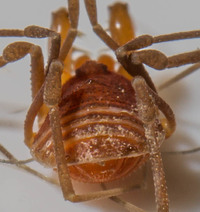Distribution Records
PDF
Vetting Levels |
|
Adult phenology:
High Mountains (HM) ≥ 4,000 ft.
Low Mountains (LM) < 4,000 ft.
Piedmont (Pd)
Coastal Plain (CP)
Click on graph to enlarge
|
 |
|
| synonym | |
| taxonomic_comments |
One of two species in this genus, both of which occur in the East (Kury, 2003); only laciniosa occurs in North Carolina. Kury (2002) keeps Bishopella in the Phalangodidae but moves Erebomaster and Theromaster to the Travuniidae. |
| species_comment |
The holotype was collected in Oteen, NC (Crosby and Bishop, 1924) |
| id_comments |
A minute Armored Harvestman. The body is orange to red-orange; the legs are paler with whitish tarsi. The surface is coarsely granulate, with the granules arranged in regular transverse rows, producing a corrugated appearance especially on the abdominal segments. The ocular tubercle is also granulate and rounded above the eyes and forming an overhang at the rear. Theromaster brunneus is similar in size and appearance but is darker brown and differs in several structural features. Erebomaster acanthinus is more yellowish and does not appear to overlap in range with Bishopella in North Carolina. |
| total_length |
3.1 mm, male (Crosby and Bishop, 1924) |
| structural_features |
The tarsus of the palp is armed with two large spine-bearing tubercles on the inner side; Theromaster and Erebomaster have three (Crosby and Bishop, 1924). |
| silk_web |
|
| fld_guide_descriptions |
|
| online_photos |
BugGuide |
| prey |
|
| predators |
|
| behavior |
|
| distribution_reference |
Crosby and Bishop (1924) |
| technical_reference |
Crosby and Bishop (1924) |
| adult_id | 1 identifiable by photo 2 identifiable by photo of specific features and/or supplementary info 3 identifiable from specimen only |
| abundance |
This species appears to be one of the more frequently collected small harvestmen in our mountains, wih several specimens often collected on a given occasion. Without knowing more about negative findings and in the absence of total counts, however, neither the frequency of occurrence or abundance of this species can be accurately estimated. |
| distribution_comments |
|
checklist_mt_high
>=4,000 ft. | |
checklist_mt_low
<4,000 ft. | |
checklist_pd
Piedmont | |
checklist_cp
Coastal Plain | |
| habitat |
North Carolina records frequently come from Boulderfield Forests or other rocky areas within wet to mesic forests. Elsewhere in the Southeast and Ohio River Valley, it has commonly been collected in caves (Kury, 2003). |
| observation_methods |
Best found by sifting leaf litter or through use of Berlese funnels |
| state_protection |
Arachnids are not protected under state law, although permits are needed to collect them in State Parks and other public and private nature preserves |
| NHP_ranks |
[GNR] [S3S4] |
| NHP_status |
|
| status_comments |
This is one of the most frequently collected of our montane, cryophilic harvestmen. Nonetheless, its habitat specializations probably make it vulnerable to the dessicating impacts associated with clear-cutting and it may be susceptible to both the heating and drying effects of global climate change. While populations currently appear to be fairly numerous and widespread, this species along with the other cryophilic biota of the mountains should be monitored for downward changes. |
Photo Gallery for Bishopella laciniosa No common name |
 | Recorded by: Carol Tingley
Transylvania Co.
Comment: Collected from leaf litter |  | Recorded by: Carol Tingley
Transylvania Co.
Comment: Collected from leaf litter |
|